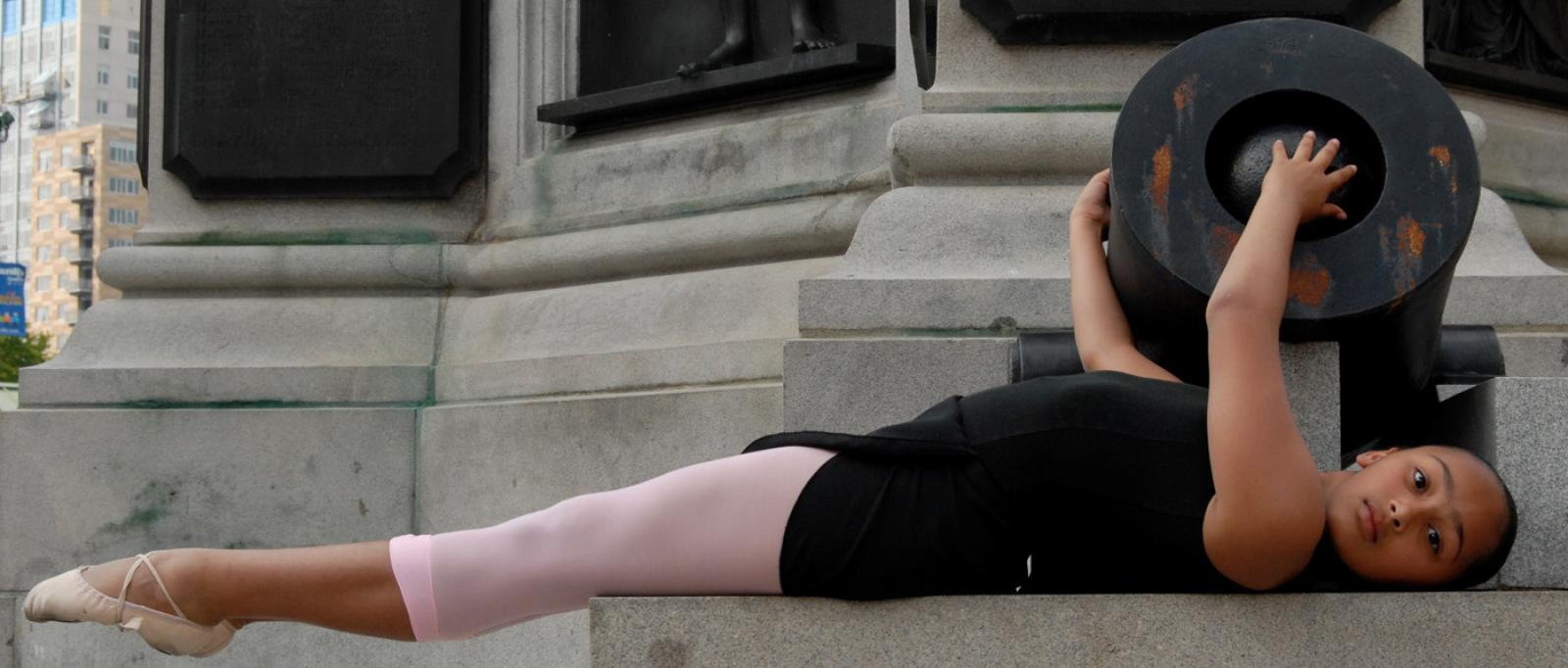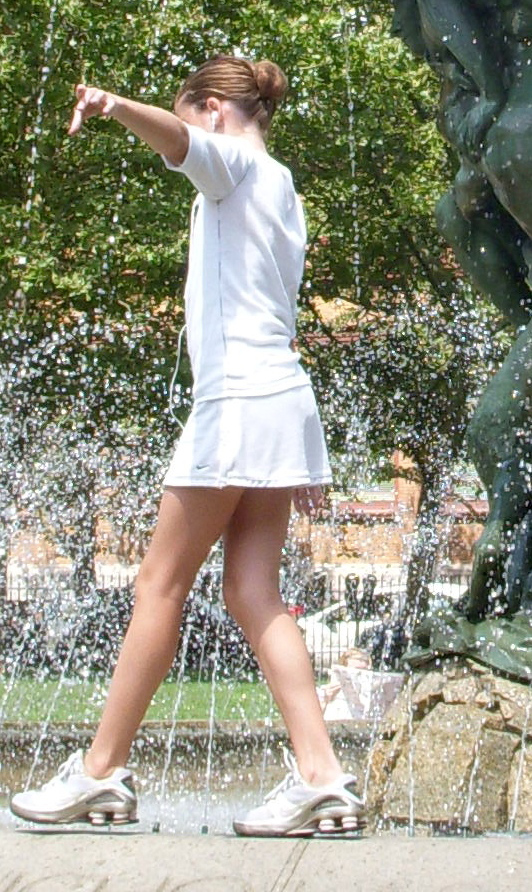At the end of last Saturday’s afternoon performance at the Yard Mary Paula Hunter, the founder of the dance company Jump, took a bow with her dancers, all of them teenage girls. The girls wore what one might expect classically trained dancers to wear. Leotards, ballet shoes, a tutu or two here and there.
Ms. Hunter, on the other hand, wore the ragged remains of a wedding dress. She was also covered in food.
Ms. Hunter had begun her final dance, a piece entitled I Am Karen Finley, by coating herself in Pam. Then she dumped an entire bag of flour on her head. After taking a break from the food to continue her dance, which included cracking a few raw eggs with her stiletto heels, she poured a carton of hot fudge down the front of her dress. By the end of the dance, chunks of white bread lay about her shoulders, cracker crumbs stuck to her arms, whipped cream dripped from her ears, and Cheez Whiz puddles oozed among her clavicles.
There were many children in the audience, all of them nearly paralyzed with glee. Was this really happening, their gasps seemed to ask. A few rubbed their eyes in disbelief. Giggles were at first hesitant. Was it okay to laugh or would this woman soon be scolded and given a time-out? The children looked to their parents, all of whom were enjoying themselves immensely. Finally, the kids let loose their laughter and it filled the room all the way to the rafters.
After cleaning up, Ms. Hunter sat on the risers icing her knee, which was dark blue and swollen. The teenaged dancers stood in front of her working out the kinks of one of their numbers before that evening’s performance.
“Your frogs look murky,” Ms. Hunter said. “But that’s my fault. I’ve edited you up to the last minute. I’m sorry. But still, now you have to own it.”
The girls went back to their frogs. Their pliés became deeper, the expressions on their faces more frog-like, the lines of their bodies more pronounced.
The scene was both funny and serious. These young dancers could be playful and yet at the same time the refinement of their technique, a blend of ballet and modern dance, was unmistakable. They were seasoned performers.
“I started with Mary Paula when I was three years old,” Elena Bonitati said. Miss Bonitati is now the ripe old age of 14.
Jump dancers often begin with creative movement classes, move up to ballet, and then ease into the official Jump program when they are eight or nine years old. The Jump program is based in Providence, R.I., but evolved out of the New York dance movement which blended classical ballet with modern dance. Serious skill and dance discipline coupled with an anything-goes atmosphere.
The food piece is a prime example, of course, but it is just one number among many. But it is an important one because it reveals so much of the personality of this dance company.
“That piece shows that dance doesn’t have to be girls in pretty costumes, flitting about on stage,” said Jessica Coons, age 17 and about to head off to college. “It can be something much more meaningful than that.”
Many of the other pieces performed by the teenage dancers reflected this ethos of girl power over girl objectification. Barbie, set to the music of Barbie Girl by Aqualung, poked fun at the archetypal notion of girls as little smiling machines programmed to be delightful and cute. Rip Her to Shreds, set to Blondie’s Rip Her to Shreds, introduced the far-too common activity of placing our girls on pedestals only to cut them down to size if they don’t meet society's every desire. GI Jessica, set to Ennio Morricone’s score for the spaghetti western, The Good, the Bad, and the Ugly, seemed to operate in more of a gray area. A condemnation of America’s incessant flexing of its military muscle, boys with big toys, if you will. And yet at the same time it encouraged the idea that the feminine mystique is vast enough to include dancers dressed in camouflage hauling heavy artillery.
Each dance piece, an expert balancing act of using humor to deepen a mood, begs the question: where do these ideas come from? The answer is what makes this dance company so unique. They come from the dancers themselves.
Learning to dance usually requires students simply to do what they are told. At Jump, students do what moves them.
“Essentially we put on the music and just sort of mess around with it individually,” explained Miss Coons. “Everyone makes up an eight or 16-count phrase and then shows the phrases to the group. We critique it, start meshing it together to create a skeleton or outline and then start the editing process.”
“It’s like a show-and-tell sort of thing,” added Sophie Herried, age 15. “Then we all take turns saying what didn’t go with the music and what reminded us of the music. You just sort of play off each other.”
If that sounds like a lot of freewheeling fun, it is.
“I learned from a young age that you can just improvise and if you do what your body feels like you can turn it into a dance,” said Miss Bonitati. But it also requires hard work and creates a ripple effect outside of the dance studio. “I also learned discipline, to be serious and dedicated about what you’re doing instead of giving up. This helps me every day,” she concluded.
For a long time Ms. Hunter made sure not to include her own work with that of her students. She didn’t want them to feel as if she were telling them what to do. That notion, however, born more from her time at universities where dancers might fear a bad grade if not emulating their instructor, began to lose its relevance with this more independent dance company. According to her dancers, the result of this meshing has been nothing but positive.
On Saturday afternoon Ms. Hunter performed another dance, this one with text, that reflected an autobiographical take on her childhood. Miss Coons noted how Mary Paula had once said in response to the question of whether the piece was true in the verbatim, that the truest truth isn’t always exactly true.
“She started with something so little, one memory, and turned it into a whole dance,” marveled Miss Coons. Had Ms. Hunter not included her own work with her dancers this insight might never have been born.
Jump has left the Vineyard, at least for now, but there is always the chance to catch them around Providence. They frequently take their performances out into the community at libraries, the Capitol steps; essentially anywhere people gather. They are also performing on Oct. 1 and 2 at Firehouse 13, a performance space at 41 Central street in downtown Providence.
If you go, expect the unexpected where content is concerned. In talent and guts, though, expect to witness a group of dancers who seem to know no limits. As Miss Coons put it, “To go out there and leave everything you’ve got on stage, that’s one of the greatest feelings there is.”








Comments
Comment policy »